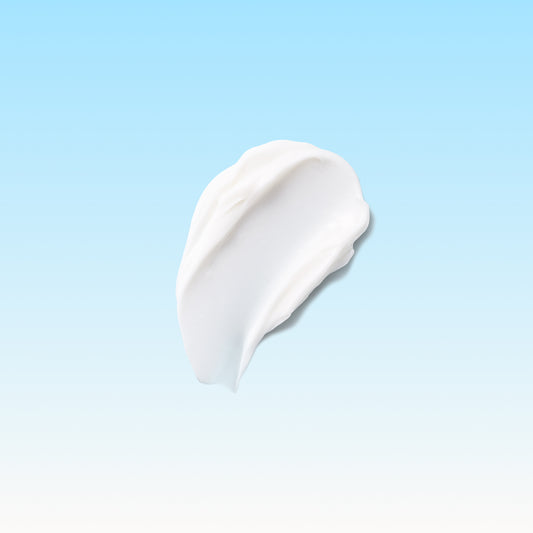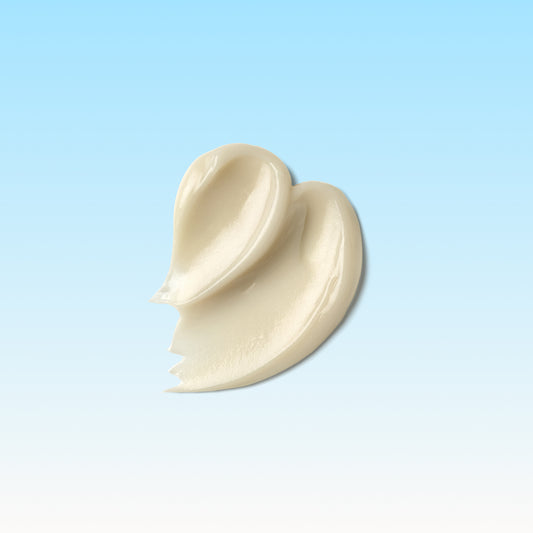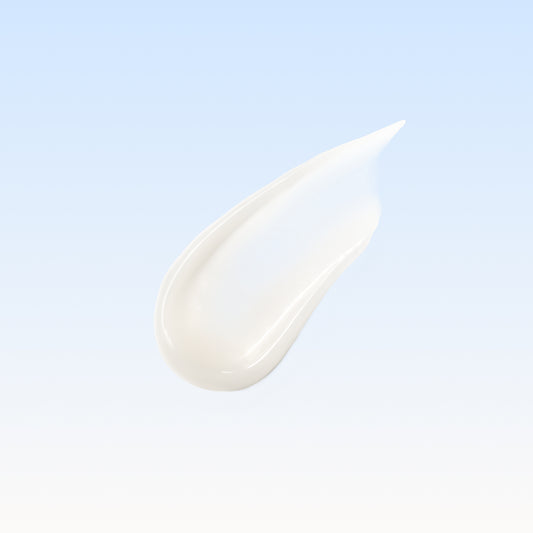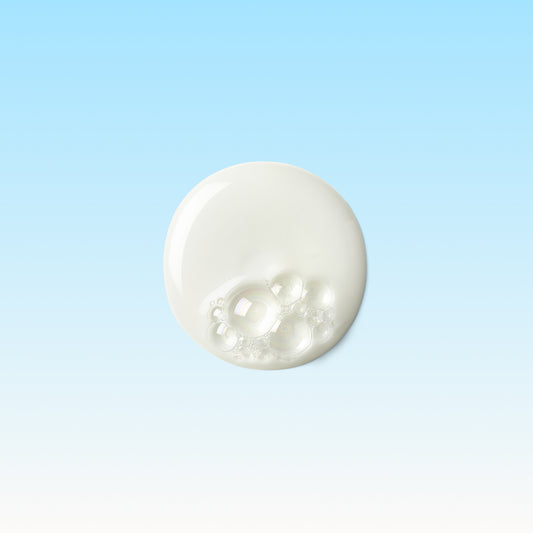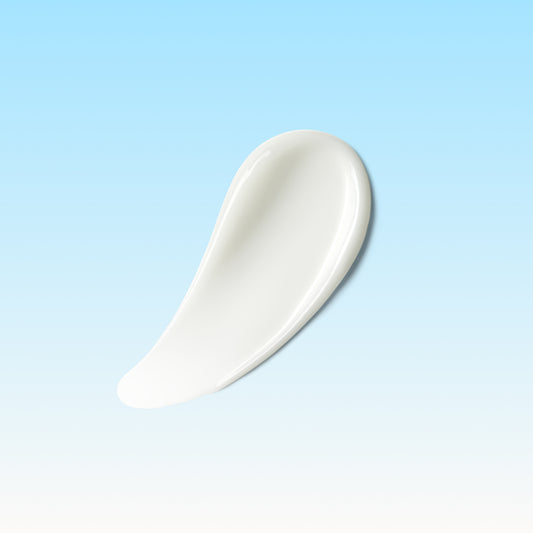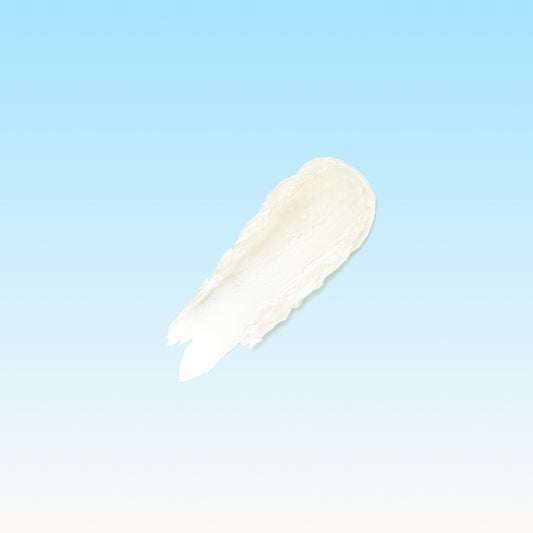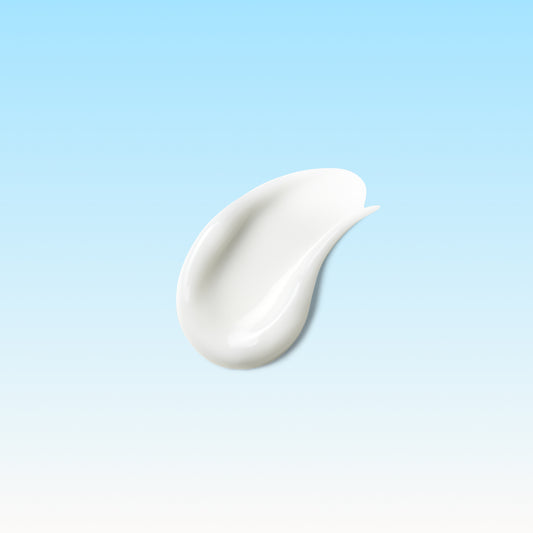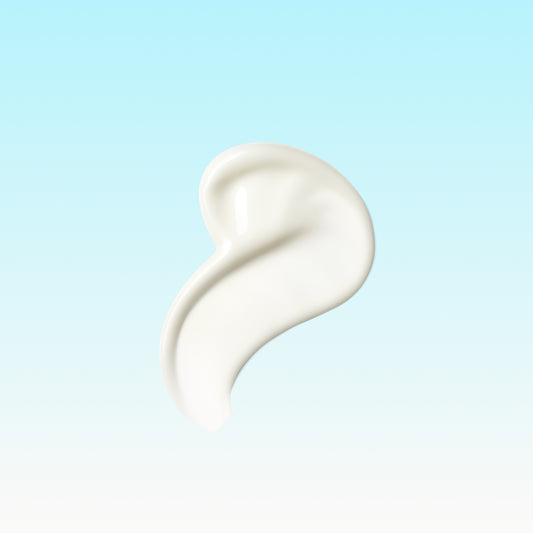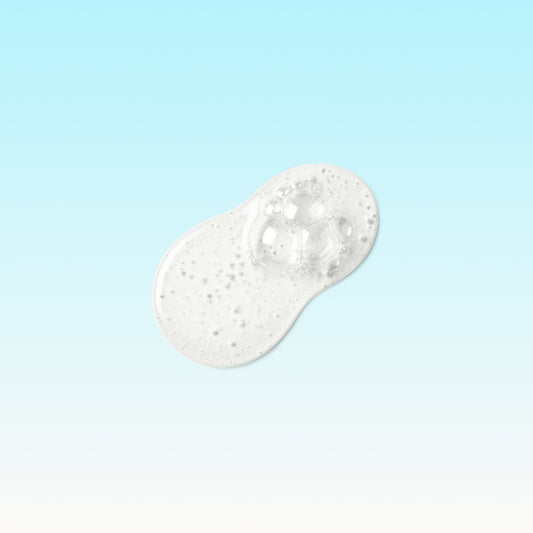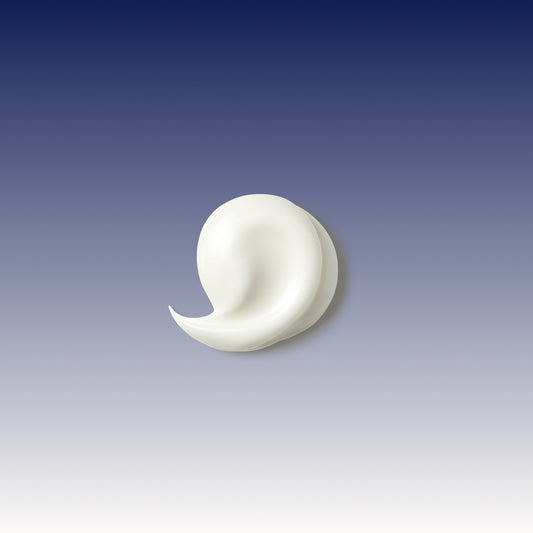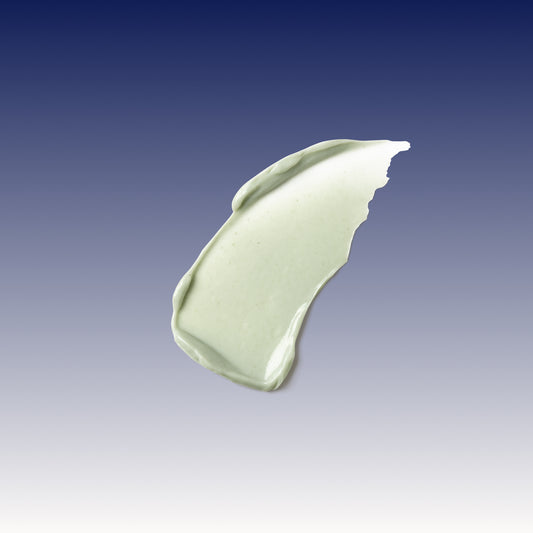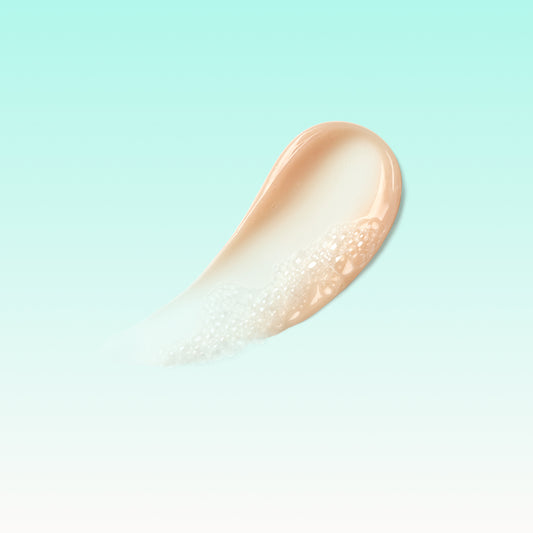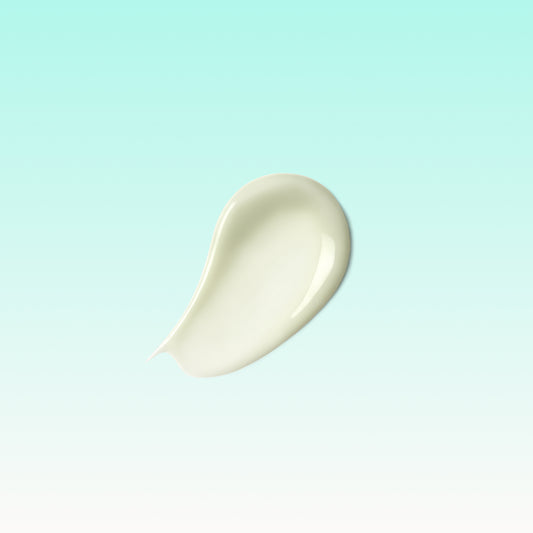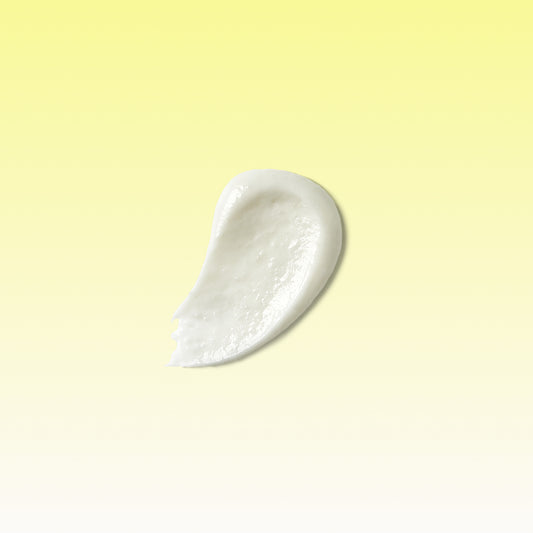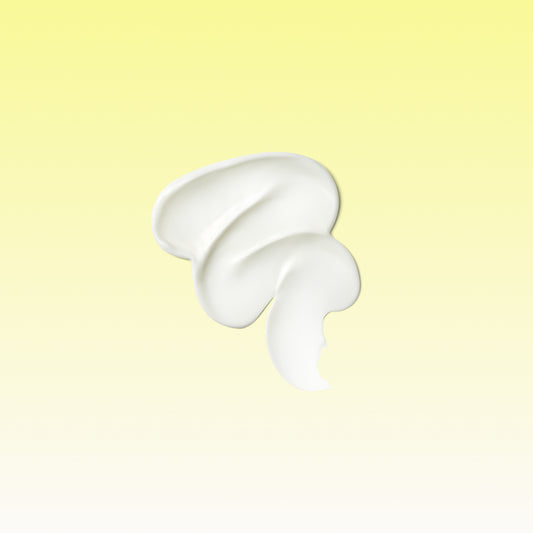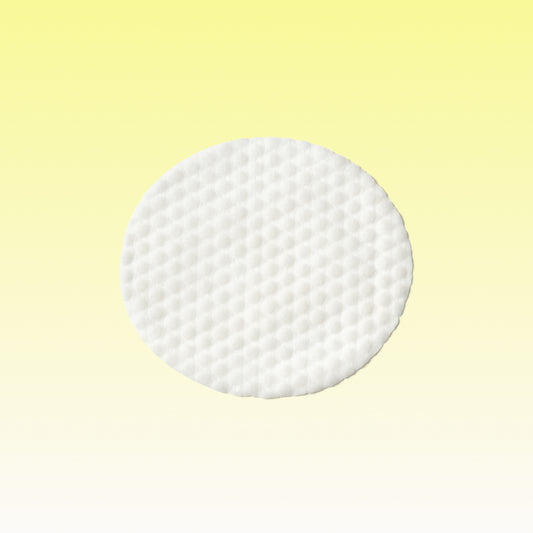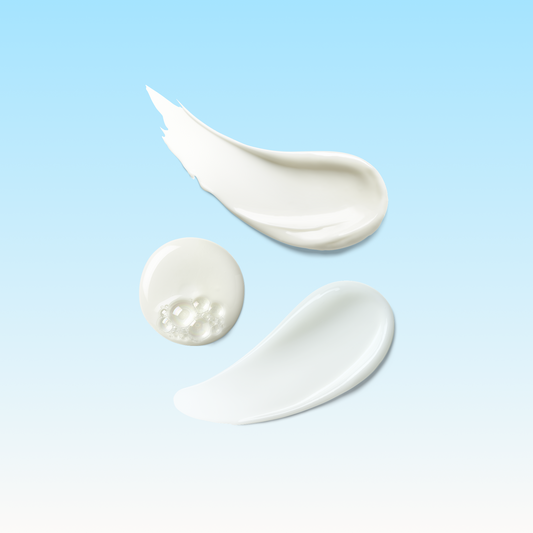Children's Skin Barrier 101

The skin barrier is not normally very strong in newborns. Components of the barrier are low and gradually increase, with most components plateauing at around three to four years. The protective moisturizer NMF is low in newborns, and peaks by age one in the elbows and nose, but not until somewhere between ages one and three in the cheeks.
A growing body of research supports the theory that an impaired skin barrier in infancy contributes to food allergies. Children with eczema—which causes barrier dysfunction—are highly likely to develop food allergies. The theory is that a leaky skin barrier allows components of foods to enter the body. Food components will be seen by the immune system as allergens that are foreign and possibly dangerous. An allergic response is mounted, consisting of antibodies and immune cells directed at particular food components, usually proteins. The next time the body is exposed to that food the immune system is primed for an allergic response.
On the other hand, if the first time the body is exposed to a new food is when a food is eaten, the immune system does not see the food as dangerous. Immune cells in the gut generally learn that when foods come in through the mouth, they do not need to mount an immune response. The body develops tolerance to foods that enter the body via the digestive tract.
The problem appears to be that when food allergens enter through the skin early in life, before the food is eaten, the body has not yet had a chance to recognize the substances as foods and to develop tolerance. Strengthening the skin barrier may help to prevent allergens entering infants’ bodies.
Related Posts
https://ca.skinfix.com/blogs/news/skin-barrier-101-what-it-is-and-how-to-keep-it-healthy
https://ca.skinfix.com/blogs/news/how-to-know-if-the-skin-barrier-is-damaged
https://ca.skinfix.com/blogs/news/what-weakens-the-skin-barrier
https://ca.skinfix.com/blogs/news/how-to-keep-the-skin-barrier-healthy
https://ca.skinfix.com/blogs/news/best-skin-barrier-ingredients
https://ca.skinfix.com/blogs/news/skin-barrier-clinical-trials
References
Addy, J., Oliphant, T., & Harper, R. (2017). A botanically derived skin surface lipid mimetic based on the composition of healthy 22-year-old females. Journal of Cosmetic Science, 68(1), 59–67.
Agero, A. L. C., & Verallo-Rowell, V. M. (2004). A randomized double-blind controlled trial comparing extra virgin coconut oil with mineral oil as a moisturizer for mild to moderate xerosis. Dermatitis: Contact, Atopic, Occupational, Drug, 15(3), 109–116. https://doi.org/10.2310/6620.2004.04006
Alexander, H., Brown, S., Danby, S., & Flohr, C. (2018). Research Techniques Made Simple: Transepidermal Water Loss Measurement as a Research Tool. Journal of Investigative Dermatology, 138(11), 2295-2300.e1. https://doi.org/10.1016/j.jid.2018.09.001
Aerts, O., Verhulst, L., & Goossens, A. (2016). Ethylhexylglycerin: A low-risk, but highly relevant, sensitizer in ‘hypo-allergenic’ cosmetics. Contact Dermatitis, 74(5), 281–288. https://doi.org/10.1111/cod.12546
American Academy of Dermatology. (n.d.). Eczema treatment: Corticosteroids applied to the skin. Retrieved May 5, 2023, from https://www.aad.org/public/diseases/eczema/childhood/treating/corticosteroids-applied-to-skin
Becker, L. C., Bergfeld, W. F., Belsito, D. V., Klaassen, C. D., Marks, J. G., Shank, R. C., Slaga, T. J., Snyder, P. W., & Andersen, F. A. (2010). Final Report of the Safety Assessment of Allantoin and Its Related Complexes. International Journal of Toxicology, 29(3_suppl), 84S-97S. https://doi.org/10.1177/1091581810362805
Bhatia, N., Del Rosso, J., Zeichner, J., & Berman, B. (2018). The Importance of Skin Barrier Maintenance and Repair: Underlying Pathophysiology, Topical Formulations, Selected Natural Ingredients, and Clinical Study Outcomes. Journal of Clinical and Aesthetic Dermatology, 11(1 Supplement), S3–S8.
Biniek, K., Levi, K., & Dauskardt, R. H. (2012). Solar UV radiation reduces the barrier function of human skin. Proceedings of the National Academy of Sciences, 109(42), 17111–17116. https://doi.org/10.1073/pnas.1206851109
Boo, Y. C. (2021). Mechanistic Basis and Clinical Evidence for the Applications of Nicotinamide (Niacinamide) to Control Skin Aging and Pigmentation. Antioxidants, 10(8), Article 8. https://doi.org/10.3390/antiox10081315
Borkow, G. (2014). Using Copper to Improve the Well-Being of the Skin. Current Chemical Biology, 8(2), 89–102. https://doi.org/10.2174/2212796809666150227223857
Bouslimani, A., da Silva, R., Kosciolek, T., Janssen, S., Callewaert, C., Amir, A., Dorrestein, K., Melnik, A. V., Zaramela, L. S., Kim, J.-N., Humphrey, G., Schwartz, T., Sanders, K., Brennan, C., Luzzatto-Knaan, T., Ackermann, G., McDonald, D., Zengler, K., Knight, R., & Dorrestein, P. C. (2019). The impact of skin care products on skin chemistry and microbiome dynamics. BMC Biology, 17(1), 47. https://doi.org/10.1186/s12915-019-0660-6
Becker, L. C., Bergfeld, W. F., Belsito, D. V., Klaassen, C. D., Marks, J. G., Shank, R. C., Slaga, T. J., Snyder, P. W., & Andersen, F. A. (2010). Final Report of the Safety Assessment of Allantoin and Its Related Complexes. International Journal of Toxicology, 29(3_suppl), 84S-97S. https://doi.org/10.1177/1091581810362805
Blaak, J., & Staib, P. (2022). An updated review on efficacy and benefits of sweet almond, evening primrose and jojoba oils in skin care applications. International Journal of Cosmetic Science, 44(1), 1–9. https://doi.org/10.1111/ics.12758
Boo, Y. C. (2021). Mechanistic Basis and Clinical Evidence for the Applications of Nicotinamide (Niacinamide) to Control Skin Aging and Pigmentation. Antioxidants, 10(8), Article 8. https://doi.org/10.3390/antiox10081315
Boxberger, M., Cenizo, V., Cassir, N., & La Scola, B. (2021). Challenges in exploring and manipulating the human skin microbiome. Microbiome, 9(1), 125. https://doi.org/10.1186/s40168-021-01062-5
Brunt, V. E., Howard, M. J., Francisco, M. A., Ely, B. R., & Minson, C. T. (2016). Passive heat therapy improves endothelial function, arterial stiffness and blood pressure in sedentary humans. The Journal of Physiology, 594(18), 5329–5342. https://doi.org/10.1113/JP272453
Buraczewska, I., Berne, B., Lindberg, M., Törmä, H., & Lodén, M. (2007). Changes in skin barrier function following long‐term treatment with moisturizers, a randomized controlled trial. British Journal of Dermatology, 156(3), 492–498. https://doi.org/10.1111/j.1365-2133.2006.07685.x
Caglar, S., Yildiz, G. K., Bakoglu, I., & Salihoglu, O. (2020). The Effect of Sunflower Seed and Almond Oil on Preterm Infant Skin: A Randomized Controlled Trial. Advances in Skin & Wound Care, 33(8), 1. https://doi.org/10.1097/01.ASW.0000672500.18525.2e
Cao, C., Xiao, Z., Wu, Y., & Ge, C. (2020). Diet and Skin Aging—From the Perspective of Food Nutrition. Nutrients, 12(3), Article 3. https://doi.org/10.3390/nu12030870
Capone, K., Kirchner, F., Klein, S. L., & Tierney, N. K. (2020). Effects of Colloidal Oatmeal Topical Atopic Dermatitis Cream on Skin Microbiome and Skin Barrier Properties. Journal of Drugs in Dermatology, 19(5), 524–531.
Centers for Disease Control and Prevention. (2020, November). Water Disinfection with Chlorine and Chloramine. Drinking Water. https://www.cdc.gov/healthywater/drinking/public/water_disinfection.html
Centers for Disease Control and Prevention. (2020, November). Water Disinfection with Chlorine and Chloramine | Public Water Systems | Drinking Water | Healthy Water | CDC. Drinking Water. https://www.cdc.gov/healthywater/drinking/public/water_disinfection.html
Chamlin, S. L., Kao, J., Frieden, I. J., Sheu, M. Y., Fowler, A. J., Fluhr, J. W., Williams, M. L., & Elias, P. M. (2002). Ceramide-dominant barrier repair lipids alleviate childhood atopic dermatitis: Changes in barrier function provide a sensitive indicator of disease activity. Journal of the American Academy of Dermatology, 47(2), 198–208. https://doi.org/10.1067/mjd.2002.124617
Chen, H.-J., Dai, F.-J., Chen, C.-Y., Fan, S.-L., Zheng, J.-H., Huang, Y.-C., Chau, C.-F., Lin, Y.-S., & Chen, C.-S. (2021). Evaluating the Antioxidants, Whitening and Antiaging Properties of Rice Protein Hydrolysates. Molecules, 26(12), Article 12. https://doi.org/10.3390/molecules26123605
Chen, L., Dong, Y., Bhagatwala, J., Raed, A., Huang, Y., & Zhu, H. (2020). Vitamin D3 Supplementation Increases Long-Chain Ceramide Levels in Overweight/Obese African Americans: A Post-Hoc Analysis of a Randomized Controlled Trial. Nutrients, 12(4), Article 4. https://doi.org/10.3390/nu12040981
Choi, E. H. (2019). Aging of the skin barrier. Clinics in Dermatology, 37(4), 336–345. https://doi.org/10.1016/j.clindermatol.2019.04.009
Choi, E.-H., Man, M.-Q., Xu, P., Xin, S., Liu, Z., Crumrine, D. A., Jiang, Y. J., Fluhr, J. W., Feingold, K. R., Elias, P. M., & Mauro, T. M. (2007). Stratum Corneum Acidification Is Impaired in Moderately Aged Human and Murine Skin. Journal of Investigative Dermatology, 127(12), 2847–2856. https://doi.org/10.1038/sj.jid.5700913
Choi, J. Y., Owusu-Ayim, M., Dawe, R., Ibbotson, S., Fleming, C., & Foerster, J. (2021). Narrowband ultraviolet B phototherapy is associated with a reduction in topical corticosteroid and clinical improvement in atopic dermatitis: A historical inception cohort study. Clinical and Experimental Dermatology, 46(6), 1067–1074. https://doi.org/10.1111/ced.14676
Christophers, E., & Schröder, J.-M. (2022). Evolution of innate defense in human skin. Experimental Dermatology, 31(3), 304–311. https://doi.org/10.1111/exd.14482
Cleveland Clinic. (n.d.). Sebaceous Glands: Function, Location & Secretion. Retrieved May 4, 2023, from https://my.clevelandclinic.org/health/body/24538-sebaceous-glands
Commins, S. P. (2015). Mechanisms of Oral Tolerance. Pediatric Clinics of North America, 62(6), 1523–1529. https://doi.org/10.1016/j.pcl.2015.07.013
Cooke, A., Cork, M. J., Victor, S., Campbell, M., Danby, S., Chittock, J., & Lavender, T. (2016). Olive Oil, Sunflower Oil or no Oil for Baby Dry Skin or Massage: A Pilot, Assessor-blinded, Randomized Controlled Trial (the Oil in Baby SkincaRE [OBSeRvE] Study). Acta Dermato-Venereologica, 96(3), Article 3. https://doi.org/10.2340/00015555-2279
Couto, M., Bernard, A., Delgado, L., Drobnic, F., Kurowski, M., Moreira, A., Rodrigues-Alves, R., Rukhadze, M., Seys, S., Wiszniewska, M., & Quirce, S. (2021). Health effects of exposure to chlorination by-products in swimming pools. Allergy, 76(11), 3257–3275. https://doi.org/10.1111/all.15014
Damian, D. L. (2017). Nicotinamide for skin cancer chemoprevention. Australasian Journal of Dermatology, 58(3), 174–180. https://doi.org/10.1111/ajd.12631
Danby, S. G., AlEnezi, T., Sultan, A., Lavender, T., Chittock, J., Brown, K., & Cork, M. J. (2013). Effect of Olive and Sunflower Seed Oil on the Adult Skin Barrier: Implications for Neonatal Skin Care. Pediatric Dermatology, 30(1), 42–50. https://doi.org/10.1111/j.1525-1470.2012.01865.x
Danby, S. G., Brown, K., Wigley, A. M., Chittock, J., Pyae, P. K., Flohr, C., & Cork, M. J. (2018). The Effect of Water Hardness on Surfactant Deposition after Washing and Subsequent Skin Irritation in Atopic Dermatitis Patients and Healthy Control Subjects. Journal of Investigative Dermatology, 138(1), 68–77. https://doi.org/10.1016/j.jid.2017.08.037
Darmstadt, G., Mao-Qiang, M., Chi, E., Saha, S., Ziboh, V., Black, R., Santosham, M., & Elias, P. (2002). Impact of topical oils on the skin barrier: Possible implications for neonatal health in developing countries. Acta Paediatrica, 91(5), 546–554. https://doi.org/10.1111/j.1651-2227.2002.tb03275.x
Dębińska, A., & Sozańska, B. (2023). Epicutaneous Sensitization and Food Allergy: Preventive Strategies Targeting Skin Barrier Repair-Facts and Challenges. Nutrients, 15(5), 1070. https://doi.org/10.3390/nu15051070
de Macedo, L. M., Santos, É. M. dos, Militão, L., Tundisi, L. L., Ataide, J. A., Souto, E. B., & Mazzola, P. G. (2020). Rosemary (Rosmarinus officinalis L., syn Salvia rosmarinus Spenn.) and Its Topical Applications: A Review. Plants, 9(5), Article 5. https://doi.org/10.3390/plants9050651
Dendooven, E., Kerre, S., Foubert, K., Pieters, L., Lambert, J., Goossens, A., & Aerts, O. (2021). Allergic contact dermatitis from potassium sorbate and sorbic acid in topical pharmaceuticals and medical devices. Contact Dermatitis, 85(2), 171–177. https://doi.org/10.1111/cod.13829
Diaz, D., & Ditre, C. M. (2020). The Effect of Cleansers on the Skin Microbiome. Practical Dermatology, 62–65.
Donald, A., & Babcock, M. (2017). Comparison of an Anhydrous OTC Balm Containing 15% Zinc Oxide, 2% Colloidal Oatmeal, and 1% Allantoin Versus 1% Hydrocortisone Cream in Subjects with Mild-to-Moderate Dermatitis. SKIN The Journal of Cutaneous Medicine, 1(3.1), s35.
Donald A, Babcock M. (2017) Efficacy and Tolerability Of An OTC Cream When Used By Subjects With Clinically Determined Moderate To Severe Xerosis On The Hands. Poster presentation. Winter Clinical Dermatology. 13–18 January 2017.
Donald, A., & Rozanski, R. (2017). Efficacy and Consumer Perception of a 96% Natural Cream Containing Lime Pearl Extract and Willow Bark Extract when Used by Subjects with Clinically Determined Keratosis Pilaris. SKIN The Journal of Cutaneous Medicine, 1(3.1), s68.
Draelos, Z. D., & Donald, A. (2018). The Effect of an Anti-Inflammatory Botanical Cleanser/Night Mask Combination on Facial Redness Reduction. Journal of Drugs in Dermatology: JDD, 17(6), 671–676.
Draelos, Z. D., Ertel, K., & Berge, C. (2005). Niacinamide-containing facial moisturizer improves skin barrier and benefits subjects with rosacea. Cutis, 76(2), 135–141.
Dréno, B., Zuberbier, T., Gelmetti, C., Gontijo, G., & Marinovich, M. (2019). Safety review of phenoxyethanol when used as a preservative in cosmetics. Journal of the European Academy of Dermatology and Venereology, 33(S7), 15–24. https://doi.org/10.1111/jdv.15944
Elias, P. M. (2022). Optimizing emollient therapy for skin barrier repair in atopic dermatitis. Annals of Allergy, Asthma & Immunology, 128(5), 505–511. https://doi.org/10.1016/j.anai.2022.01.012
Elias, P. M., & Sugarman, J. (2018). Does moisturizing the skin equate with barrier repair therapy? Annals of Allergy, Asthma & Immunology, 121(6), 653-656.e2. https://doi.org/10.1016/j.anai.2018.07.008
Environmental Working Group. (n.d.). Cyclomethicone. EWG’s Skin Deep. Retrieved May 5, 2023, from http://www.ewg.org/skindeep/ingredients/701738-CYCLOMETHICONE/
Environmental Working Group. (n.d.). Dimethicone. EWG’s Skin Deep. Retrieved May 5, 2023, from http://www.ewg.org/skindeep/ingredients/702011-DIMETHICONE/
Environmental Working Group. (n.d.). Methylparaben. EWG’s Skin Deep. Retrieved May 5, 2023, from http://www.ewg.org/skindeep/ingredients/703937-METHYLPARABEN/
Environmental Working Group. (n.d.). PEG-7 Glyceryl Cocoate. EWG’s Skin Deep. Retrieved May 5, 2023, from http://www.ewg.org/skindeep/ingredients/704645-PEG7_GLYCERYL_COCOATE/
Environmental Working Group. (n.d.). Propylene Glycol. EWG’s Skin Deep. Retrieved May 5, 2023, from http://www.ewg.org/skindeep/ingredients/705315-PROPYLENE_GLYCOL/
Environmental Working Group. (n.d.). Search Results || Skin Deep® Cosmetics Database EDTA. EWG’s Skin Deep. Retrieved May 5, 2023, from http://www.ewg.org/skindeep/search/?search=edta
European Commission Scientific Committee on Consumer Safety. (2012, June). Opinion on Fragrance Allergens in Cosmetic Products. European Commission. https://ec.europa.eu/health/scientific_committees/opinions_layman/perfume-allergies/en/l-3/1-introduction.htm
Evangelista, M. T. P., Abad-Casintahan, F., & Lopez-Villafuerte, L. (2014). The effect of topical virgin coconut oil on SCORAD index, transepidermal water loss, and skin capacitance in mild to moderate pediatric atopic dermatitis: A randomized, double-blind, clinical trial. International Journal of Dermatology, 53(1), 100–108. https://doi.org/10.1111/ijd.12339
Fadadu, R. P., Abuabara, K., Balmes, J. R., Hanifin, J. M., & Wei, M. L. (2023). Air Pollution and Atopic Dermatitis, from Molecular Mechanisms to Population-Level Evidence: A Review. International Journal of Environmental Research and Public Health, 20(3), 2526. https://doi.org/10.3390/ijerph20032526
Fadadu, R. P., Green, M., Jewell, N. P., Grimes, B., Vargo, J., & Wei, M. L. (2022). Association of Exposure to Wildfire Air Pollution With Exacerbations of Atopic Dermatitis and Itch Among Older Adults. JAMA Network Open, 5(10), e2238594. https://doi.org/10.1001/jamanetworkopen.2022.38594
Farvid, M. S., Ding, M., Pan, A., Sun, Q., Chiuve, S. E., Steffen, L. M., Willett, W. C., & Hu, F. B. (2014). Dietary Linoleic Acid and Risk of Coronary Heart Disease: A Systematic Review and Meta-Analysis of Prospective Cohort Studies. Circulation, 130(18), 1568–1578. https://doi.org/10.1161/CIRCULATIONAHA.114.010236
Filip, D., Macocinschi, D., Zaltariov, M.-F., Gafitanu, C. A., Tuchilus, C. G., Bele, A., Ciubotaru, B.-I., Stoleru, E., & Bargan, A. (2022). Mucoadhesive and Antimicrobial Allantoin/β Cyclodextrins-Loaded Carbopol Gels as Scaffolds for Regenerative Medicine. Gels, 8(7), Article 7. https://doi.org/10.3390/gels8070416
Final Report on the Safety Assessment of Myristyl Myristate and Isopropyl Myristate. (1982). Journal of the American College of Toxicology, 1(4), 55–80. https://doi.org/10.3109/10915818209021261
Final Report on the Safety Assessment of Sorbitan Caprylate, Sorbitan Cocoate, Sorbitan Diisostearate, Sorbitan Dioleate, Sorbitan Distearate, Sorbitan Isostearate, Sorbitan Olivate, Sorbitan Sesquiisostearate, Sorbitan Sesquistearate, and Sorbitan Triisostearate. (2002). International Journal of Toxicology, 21(1_suppl), 93–112. https://doi.org/10.1080/10915810290096414
Fransen, M., Overgaard, L. E. K., Johansen, J. D., & Thyssen, J. P. (2018). Contact allergy to lanolin: Temporal changes in prevalence and association with atopic dermatitis. Contact Dermatitis, 78(1), 70–75. https://doi.org/10.1111/cod.12872
Gad, H. A., Roberts, A., Hamzi, S. H., Gad, H. A., Touiss, I., Altyar, A. E., Kensara, O. A., & Ashour, M. L. (2021). Jojoba Oil: An Updated Comprehensive Review on Chemistry, Pharmaceutical Uses, and Toxicity. Polymers, 13(11), Article 11. https://doi.org/10.3390/polym13111711
Garg, A., Chren, M.-M., Sands, L. P., Matsui, M. S., Marenus, K. D., Feingold, K. R., & Elias, P. M. (2001). Psychological Stress Perturbs Epidermal Permeability Barrier Homeostasis: Implications for the Pathogenesis of Stress-Associated Skin Disorders. Archives of Dermatology, 137(1), 53–59. https://doi.org/10.1001/archderm.137.1.53
Geier, J., Ballmer-Weber, B., Buhl, T., Rieker-Schwienbacher, J., Mahler, V., Dickel, H., Schubert, S., & Ivdk, F. T. (2022). Is benzyl alcohol a significant contact sensitizer? Journal of the European Academy of Dermatology and Venereology, 36(6), 866–872. https://doi.org/10.1111/jdv.17968
Goodman, D. L., McDonnel, J. T., Nelson, H. S., Vaughan, T. R., & Weber, R. W. (1990). Chronic urticaria exacerbated by the antioxidant food preservatives, butylated hydroxyanisole (BHA) and butylated hydroxytoluene (BHT). Journal of Allergy and Clinical Immunology, 86(4, Part 1), 570–575. https://doi.org/10.1016/S0091-6749(05)80214-3
Green, M., Kashetsky, N., Feschuk, A., & Maibach, H. I. (2022). Transepidermal water loss (TEWL): Environment and pollution—A systematic review. Skin Health and Disease, 2(2), e104. https://doi.org/10.1002/ski2.104
Gruber JV, Ludwig P, Holtz R. Modulation of cellular senescence in fibroblasts and dermal papillae cells in vitro. Journal of Cosmetic Science. 2013 Mar-Apr;64(2):79-87. PMID: 23578831. https://europepmc.org/article/med/23578831
Gunnarsson, M., Mojumdar, E. H., Topgaard, D., & Sparr, E. (2021). Extraction of natural moisturizing factor from the stratum corneum and its implication on skin molecular mobility. Journal of Colloid and Interface Science, 604, 480–491. https://doi.org/10.1016/j.jcis.2021.07.012
Habeebuddin, M., Karnati, R. K., Shiroorkar, P. N., Nagaraja, S., Asdaq, S. M. B., Khalid Anwer, M., & Fattepur, S. (2022). Topical Probiotics: More Than a Skin Deep. Pharmaceutics, 14(3), Article 3. https://doi.org/10.3390/pharmaceutics14030557
Harkins, C. P., Pettigrew, K. A., Oravcová, K., Gardner, J., Hearn, R. M. R., Rice, D., Mather, A. E., Parkhill, J., Brown, S. J., Proby, C. M., & Holden, M. T. G. (2018). The Microevolution and Epidemiology of Staphylococcus aureus Colonization during Atopic Eczema Disease Flare. Journal of Investigative Dermatology, 138(2), 336–343. https://doi.org/10.1016/j.jid.2017.09.023
Harris-Tryon, T. A., & Grice, E. A. (2022). Microbiota and maintenance of skin barrier function. Science, 376(6596), 940–945. https://doi.org/10.1126/science.abo0693
Hon, K. L., Leung, A. K. C., & Barankin, B. (2013). Barrier Repair Therapy in Atopic Dermatitis: An Overview. American Journal of Clinical Dermatology, 14(5), 389–399. https://doi.org/10.1007/s40257-013-0033-9
Hoober, J. K., & Eggink, L. L. (2022). The Discovery and Function of Filaggrin. International Journal of Molecular Sciences, 23(3), Article 3. https://doi.org/10.3390/ijms23031455
Ilnytska, O., Kaur, S., Chon, S., Reynertson, K. A., Nebus, J., Garay, M., Mahmood, K., & Southall, M. D. (2016). Colloidal Oatmeal (Avena sativa) Improves Skin Barrier Through Multi-Therapy Activity. Journal of Drugs in Dermatology: JDD, 15(6), 684–690.
International Cooperation on Cosmetics Regulation. (2016, March 6). Presence of 1,4-Dioxane in Cosmetic Products—SCCS Report. Chemycal.Com/News. https://chemycal.com/news/e1022d44-8139-4661-8863-70690885b1a3/Presence_of_14-Dioxane_in_Cosmetic_Products_-_SCCS_report_Comments_by_1632016
Jabbar-Lopez, Z. K., Ung, C. Y., Alexander, H., Gurung, N., Chalmers, J., Danby, S., Cork, M. J., Peacock, J. L., & Flohr, C. (2021). The effect of water hardness on atopic eczema, skin barrier function: A systematic review, meta-analysis. Clinical & Experimental Allergy, 51(3), 430–451. https://doi.org/10.1111/cea.13797
Jacobson, E. L., Kim, H., Kim, M., Williams, J. D., Coyle, D. L., Coyle, W. R., Grove, G., Rizer, R. L., Stratton, M. S., & Jacobson, M. K. (2007). A topical lipophilic niacin derivative increases NAD, epidermal differentiation and barrier function in photodamaged skin. Experimental Dermatology, 16(6), 490–499. https://doi.org/10.1111/j.1600-0625.2007.00553.x
Johnson, G. H., & Fritsche, K. (2012). Effect of Dietary Linoleic Acid on Markers of Inflammation in Healthy Persons: A Systematic Review of Randomized Controlled Trials. Journal of the Academy of Nutrition and Dietetics, 112(7), 1029-1041.e15. https://doi.org/10.1016/j.jand.2012.03.029
Johnson, L. E. (2022, November). Niacin Deficiency. Merck Manuals Consumer Version. https://www.merckmanuals.com/home/disorders-of-nutrition/vitamins/niacin-deficiency
Johnson, L. E. (2022, November). Riboflavin Deficiency. Merck Manuals Consumer Version. https://www.merckmanuals.com/home/disorders-of-nutrition/vitamins/riboflavin-deficiency
Johnson, L. E. (2022, November). Vitamin B6 Deficiency. Merck Manuals Consumer Version. https://www.merckmanuals.com/home/disorders-of-nutrition/vitamins/vitamin-b6-deficiency
Kahraman, E., Kaykın, M., Şahin Bektay, H., & Güngör, S. (2019). Recent Advances on Topical Application of Ceramides to Restore Barrier Function of Skin. Cosmetics, 6(3), Article 3. https://doi.org/10.3390/cosmetics6030052
Kahremany, S., Hofmann, L., Gruzman, A., Dinkova-Kostova, A. T., & Cohen, G. (2022). NRF2 in dermatological disorders: Pharmacological activation for protection against cutaneous photodamage and photodermatosis. Free Radical Biology and Medicine, 188, 262–276. https://doi.org/10.1016/j.freeradbiomed.2022.06.238
Kanehara, S., Ohtani, T., Uede, K., & Furukawa, F. (2007). Clinical effects of undershirts coated with borage oil on children with atopic dermatitis: A double-blind, placebo-controlled clinical trial. The Journal of Dermatology, 34(12), 811–815. https://doi.org/10.1111/j.1346-8138.2007.00391.x
Kang, S.-Y., Um, J.-Y., Chung, B.-Y., Lee, S.-Y., Park, J.-S., Kim, J.-C., Park, C.-W., & Kim, H.-O. (2022). Moisturizer in Patients with Inflammatory Skin Diseases. Medicina, 58(7), Article 7. https://doi.org/10.3390/medicina58070888
Kelleher, M. M., Phillips, R., Brown, S. J., Cro, S., Cornelius, V., Carlsen, K. C. L., Skjerven, H. O., Rehbinder, E. M., Lowe, A. J., Dissanayake, E., Shimojo, N., Yonezawa, K., Ohya, Y., Yamamoto-Hanada, K., Morita, K., Axon, E., Cork, M., Cooke, A., Van Vogt, E., … Boyle, R. J. (2022). Skin care interventions in infants for preventing eczema and food allergy. The Cochrane Database of Systematic Reviews, 11(11), CD013534. https://doi.org/10.1002/14651858.CD013534.pub3
Kim, S., Jang, J. E., Kim, J., Lee, Y. I., Lee, D. W., Song, S. Y., & Lee, J. H. (2017). Enhanced barrier functions and anti-inflammatory effect of cultured coconut extract on human skin. Food and Chemical Toxicology, 106, 367–375. https://doi.org/10.1016/j.fct.2017.05.060
Kraus, A. L., Stotts, J., Altringer, L. A., & Allgood, G. S. (1990). Allergic contact dermatitis from propyl gallate: Dose response comparison using various application methods. Contact Dermatitis, 22(3), 132–136. https://doi.org/10.1111/j.1600-0536.1990.tb01546.x
Kscomamura, H., Dor, T., Inui, S., & Yoshikawa, K. (1997). A case of contact dermatitis due to impurities of cetyl alcohol. Contact Dermatitis, 36(1), 44–46. https://doi.org/10.1111/j.1600-0536.1997.tb00921.x
Kurtz, E. S., & Wallo, W. (2007). Colloidal oatmeal: History, chemistry and clinical properties. Journal of Drugs in Dermatology: JDD, 6(2), 167–170.
Lauer, A.-C., Groth, N., Haag, S. F., Darvin, M. E., Lademann, J., & Meinke, M. C. (2013). Dose-Dependent Vitamin C Uptake and Radical Scavenging Activity in Human Skin Measured with in vivo Electron Paramagnetic Resonance Spectroscopy. Skin Pharmacology and Physiology, 26(3), 147–154. https://doi.org/10.1159/000350833
Li, Z., Hu, L., Elias, P. M., & Man, M.-Q. (2018). Skin care products can aggravate epidermal function: Studies in a murine model suggest a pathogenic role in sensitive skin: Some Skin Care Products Induce Dermatitis in Mice. Contact Dermatitis, 78(2), 151–158. https://doi.org/10.1111/cod.12909
Huang, Z.-R., Lin, Y.-K., & Fang, J.-Y. (2009). Biological and Pharmacological Activities of Squalene and Related Compounds: Potential Uses in Cosmetic Dermatology. Molecules, 14(1), Article 1. https://doi.org/10.3390/molecules14010540
Lichterfeld-Kottner, A., El Genedy, M., Lahmann, N., Blume-Peytavi, U., Büscher, A., & Kottner, J. (2020). Maintaining skin integrity in the aged: A systematic review. International Journal of Nursing Studies, 103, 103509. https://doi.org/10.1016/j.ijnurstu.2019.103509
Lin, T.-K., Zhong, L., & Santiago, J. L. (2018). Anti-Inflammatory and Skin Barrier Repair Effects of Topical Application of Some Plant Oils. International Journal of Molecular Sciences, 19(1), Article 1. https://doi.org/10.3390/ijms19010070
Lio, P. A. (2016). Rapid Improvement and Protective Effects of an Almond Oil-Based Ointment for Diaper Dermatitis. Journal of Drugs in Dermatology, 15(11), S86.
Liu-Walsh, F., Tierney, N. K., Hauschild, J., Rush, A. K., Masucci, J., Leo, G. C., & Capone, K. A. (2021). Prebiotic Colloidal Oat Supports the Growth of Cutaneous Commensal Bacteria Including S. epidermidis and Enhances the Production of Lactic Acid. Clinical, Cosmetic and Investigational Dermatology, 14, 73–82. https://doi.org/10.2147/CCID.S253386
Lodén, M. (2012). Effect of moisturizers on epidermal barrier function. Clinics in Dermatology, 30(3), 286–296. https://doi.org/10.1016/j.clindermatol.2011.08.015
Lodén, M., & Bárány, E. (2000). Skin-identical lipids versus petrolatum in the treatment of tape-stripped and detergent-perturbed human skin. Acta Dermato-Venereologica, 80(6), 412–415. https://doi.org/10.1080/000155500300012774
Ludovici, M., Kozul, N., Materazzi, S., Risoluti, R., Picardo, M., & Camera, E. (2018). Influence of the sebaceous gland density on the stratum corneum lipidome. Scientific Reports, 8(1), Article 1. https://doi.org/10.1038/s41598-018-29742-7
Lukić, M., Pantelić, I., & Savić, S. D. (2021). Towards Optimal pH of the Skin and Topical Formulations: From the Current State of the Art to Tailored Products. Cosmetics, 8(3), Article 3. https://doi.org/10.3390/cosmetics8030069
Maliyil, B. T., Koshy, R. R., Madhavan, A. T., & Korrapati, N. H. (2023). Trust your sunscreen with caution: A literature review on the side effects of sunscreen. Cosmoderma, 3. https://doi.org/10.25259/CSDM_52_2023
Man, M.-Q., Wakefield, J. S., Mauro, T. M., & Elias, P. M. (2022). Alterations in epidermal function in type 2 diabetes: Implications for the management of this disease. Journal of Diabetes, 14(9), 586–595. https://doi.org/10.1111/1753-0407.13303
McAleer, M. A., Jakasa, I., Raj, N., O’Donnell, C. P. F., Lane, M. E., Rawlings, A. V., Voegeli, R., McLean, W. H. I., Kezic, S., & Irvine, A. D. (2018). Early‐life regional and temporal variation in filaggrin‐derived natural moisturizing factor, filaggrin‐processing enzyme activity, 8of Dermatology, 179(2), 431–441. https://doi.org/10.1111/bjd.16691
McGowan, M. A., Scheman, A., & Jacob, S. E. (2018). Propylene Glycol in Contact Dermatitis A Systematic Review. Dermatitis, 29(1), 6–12. https://doi.org/10.1097/DER.0000000000000307
Meisel, J. S., Sfyroera, G., Bartow-McKenney, C., Gimblet, C., Bugayev, J., Horwinski, J., Kim, B., Brestoff, J. R., Tyldsley, A. S., Zheng, Q., Hodkinson, B. P., Artis, D., & Grice, E. A. (2018). Commensal microbiota modulate gene expression in the skin. Microbiome, 6(1), 20. https://doi.org/10.1186/s40168-018-0404-9
Merchel Piovesan Pereira, B., & Tagkopoulos, I. (2019). Benzalkonium Chlorides: Uses, Regulatory Status, and Microbial Resistance. Applied and Environmental Microbiology, 85(13), e00377-19. https://doi.org/10.1128/AEM.00377-19
Micera, M., Botto, A., Geddo, F., Antoniotti, S., Bertea, C. M., Levi, R., Gallo, M. P., & Querio, G. (2020). Squalene: More than a Step toward Sterols. Antioxidants, 9(8), Article 8. https://doi.org/10.3390/antiox9080688
Mijaljica, D., Spada, F., & Harrison, I. P. (2022). Skin Cleansing without or with Compromise: Soaps and Syndets. Molecules, 27(6), Article 6. https://doi.org/10.3390/molecules27062010
Miller, E. R., Pastor-Barriuso, R., Dalal, D., Riemersma, R. A., Appel, L. J., & Guallar, E. (2005). Meta-Analysis: High-Dosage Vitamin E Supplementation May Increase All-Cause Mortality. Annals of Internal Medicine, 142(1), 37–46. https://doi.org/10.7326/0003-4819-142-1-200501040-00110
Monteiro-Riviere, N. A., Wiench, K., Landsiedel, R., Schulte, S., Inman, A. O., & Riviere, J. E. (2011). Safety Evaluation of Sunscreen Formulations Containing Titanium Dioxide and Zinc Oxide Nanoparticles in UVB Sunburned Skin: An In Vitro and In Vivo Study. Toxicological Sciences, 123(1), 264–280. https://doi.org/10.1093/toxsci/kfr148
Montero-Vilchez, T., Martinez-Lopez, A., Cuenca-Barrales, C., Quiñones-Vico, M. I., Sierra-Sanchez, A., Molina-Leyva, A., Gonçalo, M., Cambil-Martin, J., & Arias-Santiago, S. (2022). Assessment of hand hygiene strategies on skin barrier function during COVID-19 pandemic: A randomized clinical trial. Contact Dermatitis, 86(4), 276–285. https://doi.org/10.1111/cod.14034
Mogensen, K. M. (2017). Essential Fatty Acid Deficiency. Practical Gastroenterology, 37–44.
Murphy, B., Grimshaw, S., Hoptroff, M. et al. Alteration of barrier properties, stratum corneum ceramides and microbiome composition in response to lotion application on cosmetic dry skin. Sci Rep 12, 5223 (2022). https://doi.org/10.1038/s41598-022-09231-8
Nasser, K. K., Banaganapalli, B., Shinawi, T., Elango, R., & Shaik, N. A. (2021). Molecular profiling of lamellar ichthyosis pathogenic missense mutations on the structural and stability aspects of TGM1 protein. Journal of Biomolecular Structure and Dynamics, 39(14), 4962–4972. https://doi.org/10.1080/07391102.2020.1782770
National Eczema Association. (n.d.). An Overview of the Different Types of Eczema. Retrieved May 4, 2023, from https://nationaleczema.org/eczema/types-of-eczema/
National Eczema Association. (n.d.). Available Eczema Treatments. National Eczema Association. Retrieved May 5, 2023, from https://nationaleczema.org/eczema/treatment/
National Eczema Association. (n.d.). Prescription Topicals. Retrieved May 5, 2023, from https://nationaleczema.org/eczema/treatment/topicals/
National Eczema Association. (n.d.). What is atopic dermatitis and how can I tell if I have it? Atopic Dermatitis. Retrieved May 4, 2023, from https://nationaleczema.org/eczema/types-of-eczema/atopic-dermatitis/
National Eczema Association. (n.d.). What is contact dermatitis and how is it treated? Contact Dermatitis. Retrieved May 4, 2023, from https://nationaleczema.org/eczema/types-of-eczema/contact-dermatitis/
Ni Raghallaigh, S., Bender, K., Lacey, N., Brennan, L., & Powell, F. C. (2012). The fatty acid profile of the skin surface lipid layer in papulopustular rosacea. British Journal of Dermatology, 166(2), 279–287. https://doi.org/10.1111/j.1365-2133.2011.10662.x
Nouwen, A. E. M., Schappin, R., Nguyen, N. T., Ragamin, A., Bygum, A., Bodemer, C., Dalm, V. A. S. H., & Pasmans, S. G. M. A. (2022). Outcomes of Systemic Treatment in Children and Adults With Netherton Syndrome: A Systematic Review. Frontiers in Immunology, 13. https://www.frontiersin.org/articles/10.3389/fimmu.2022.864449
Ouzir, M., Bernoussi, S. E., Tabyaoui, M., & Taghzouti, K. (2021). Almond oil: A comprehensive review of chemical composition, extraction methods, preservation conditions, potential health benefits, and safety. Comprehensive Reviews in Food Science and Food Safety, 20(4), 3344–3387. https://doi.org/10.1111/1541-4337.12752
Pan, M., Heinecke, G., Bernardo, S., Tsui, C., & Levitt, J. (2013). Urea: A comprehensive review of the clinical literature. Dermatology Online Journal, 19(11). https://doi.org/10.5070/D31911020392
Panico, A., Serio, F., Bagordo, F., Grassi, T., Idolo, A., Giorgi, M. D., Guido, M., Congedo, M., & Donno, A. D. (2019). Skin Safety and Health Prevention: An Overview of Chemicals in Cosmetic Products. Journal of Preventive Medicine and Hygiene, 60(1), Article 1. https://doi.org/10.15167/2421-4248/jpmH1019.60.1.1080
Paciência, I., Rodolfo, A., Leão, L., Silva, D., Cavaleiro Rufo, J., Mendes, F., Padrão, P., Moreira, P., Laerte Boechat, J., Delgado, L., & Moreira, A. (2021). Effects of Exercise on the Skin Epithelial Barrier of Young Elite Athletes-Swimming Comparatively to Non-Water Sports Training Session. International Journal of Environmental Research and Public Health, 18(2), Article 2. https://doi.org/10.3390/ijerph18020653
Packer, L., & Valacchi, G. (2002). Antioxidants and the Response of Skin to Oxidative Stress: Vitamin E as a Key Indicator. Skin Pharmacology and Applied Skin Physiology, 15(5), 282–290. https://doi.org/10.1159/000064531
Patzelt, A., Lademann, J., Richter, H., Darvin, M. E., Schanzer, S., Thiede, G., Sterry, W., Vergou, T., & Hauser, M. (2012). In vivo investigations on the penetration of various oils and their influence on the skin barrier. Skin Research and Technology, 18(3), 364–369. https://doi.org/10.1111/j.1600-0846.2011.00578.x
Perche, P. O., Cook, M. K., & Feldman, S. R. (2023). Abrocitinib: A New FDA-Approved Drug for Moderate-to-Severe Atopic Dermatitis. The Annals of Pharmacotherapy, 57(1), 86–98. https://doi.org/10.1177/10600280221096713
Piquero-Casals, J., Morgado-Carrasco, D., Granger, C., Trullàs, C., Jesús-Silva, A., & Krutmann, J. (2021). Urea in Dermatology: A Review of its Emollient, Moisturizing, Keratolytic, Skin Barrier Enhancing and Antimicrobial Properties. Dermatology and Therapy, 11(6), 1905–1915. https://doi.org/10.1007/s13555-021-00611-y
Proksch, E., Brandner, J. M., & Jensen, J.-M. (2008). The skin: An indispensable barrier. Experimental Dermatology, 17(12), 1063–1072. https://doi.org/10.1111/j.1600-0625.2008.00786.x
Pullar, J. M., Carr, A. C., & Vissers, M. C. M. (2017). The Roles of Vitamin C in Skin Health. Nutrients, 9(8), Article 8. https://doi.org/10.3390/nu9080866
Rawlings, A. V., & Lombard, K. J. (2012). A review on the extensive skin benefits of mineral oil. International Journal of Cosmetic Science, 34(6), 511–518. https://doi.org/10.1111/j.1468-2494.2012.00752.x
Ribeiro, A. S., Estanqueiro, M., Oliveira, M. B., & Sousa Lobo, J. M. (2015). Main Benefits and Applicability of Plant Extracts in Skin Care Products. Cosmetics, 2(2), Article 2. https://doi.org/10.3390/cosmetics2020048
Ryczaj, K., Dumycz, K., Spiewak, R., & Feleszko, W. (2022). Contact allergens in moisturizers in preventative emollient therapy – A systematic review. Clinical and Translational Allergy, 12(6), e12150. https://doi.org/10.1002/clt2.12150
Saheb Kashaf, S., Proctor, D. M., Deming, C., Saary, P., Hölzer, M., Taylor, M. E., Kong, H. H., Segre, J. A., Almeida, A., & Finn, R. D. (2022). Integrating cultivation and metagenomics for a multi-kingdom view of skin microbiome diversity and functions. Nature Microbiology, 7(1), Article 1. https://doi.org/10.1038/s41564-021-01011-w
Schlievert, P. M., & Peterson, M. L. (2020). Decolonization of Human Anterior Nares of Staphylococcus aureus with Use of a Glycerol Monolaurate Nonaqueous Gel. MSphere, 5(4), e00552-20. https://doi.org/10.1128/mSphere.00552-20
Seki, T., Morimatsu, S., Nagahori, H., & Morohashi, M. (2003). Free Residual Chlorine in Bathing Water Reduces the Water-Holding Capacity of the Stratum Corneum in Atopic Skin. The Journal of Dermatology, 30(3), 196–202. https://doi.org/10.1111/j.1346-8138.2003.tb00371.x
Sim GS, Lee DH, Kim JH, An SK, Choe TB, Kwon TJ, Pyo HB, Lee BC. Black rice (Oryza sativa L. var. japonica) hydrolyzed peptides induce expression of hyaluronan synthase 2 gene in HaCaT keratinocytes. J Microbiol Biotechnol. 2007 Feb;17(2):271-9. PMID: 18051758.
Strandberg, K. L., Peterson, M. L., Schaefers, M. M., Case, L. C., Pack, M. C., Chase, D. J., & Schlievert, P. M. (2009). Reduction in Staphylococcus aureus growth and exotoxin production and in vaginal interleukin 8 levels due to glycerol monolaurate in tampons. Clinical Infectious Diseases: An Official Publication of the Infectious Diseases Society of America, 49(11), 1711–1717. https://doi.org/10.1086/644614
Strunk, T., Pupala, S., Hibbert, J., Doherty, D., & Patole, S. (2017). Topical Coconut Oil in Very Preterm Infants: An Open-Label Randomised Controlled Trial. Neonatology, 113(2), 146–151. https://doi.org/10.1159/000480538
Tagami, H. (2008). Location-related differences in structure and function of the stratum corneum with special emphasis on those of the facial skin. International Journal of Cosmetic Science, 30(6), 413–434. https://doi.org/10.1111/j.1468-2494.2008.00459.x
Tan, C. X., Tan, S. S., & Tan, S. T. (2020). Chapter 52—Cold pressed macadamia oil. In M. F. Ramadan (Ed.), Cold Pressed Oils (pp. 587–595). Academic Press. https://doi.org/10.1016/B978-0-12-818188-1.00052-9
Tessema, E. N., Gebre-Mariam, T., Neubert, R. H. H., & Wohlrab, J. (2017). Potential Applications of Phyto-Derived Ceramides in Improving Epidermal Barrier Function. Skin Pharmacology and Physiology, 30(3), 115–138. https://doi.org/10.1159/000464337
Thiele, J. J., Hsieh, S. N., & Ekanayake-Mudiyanselage, S. (2005). Vitamin E: Critical Review of Its Current Use in Cosmetic and Clinical Dermatology. Dermatologic Surgery, 31(s1), 805–813. https://doi.org/10.1111/j.1524-4725.2005.31724
U.S. Food and Drug Administration. (2019, February 21). FDA advances new proposed regulation to make sure that sunscreens are safe and effective. FDA. https://www.fda.gov/news-events/press-announcements/fda-advances-new-proposed-regulation-make-sure-sunscreens-are-safe-and-effective
U.S. Food & Drug Administration. (2020, September 9). Antibacterial Soap? You Can Skip It, Use Plain Soap and Water. FDA. https://www.fda.gov/consumers/consumer-updates/antibacterial-soap-you-can-skip-it-use-plain-soap-and-water
U.S. Food & Drug Administration. (2022, March 3). 1,4-Dioxane in Cosmetics: A Manufacturing Byproduct. FDA; FDA. https://www.fda.gov/cosmetics/potential-contaminants-cosmetics/14-dioxane-cosmetics-manufacturing-byproduct
U.S. Food & Drug Administration. (2022, March 3). Allergens in Cosmetics. FDA. https://www.fda.gov/cosmetics/cosmetic-ingredients/allergens-cosmetics
U.S. Food & Drug Administration. (2022, March 4). Is It a Cosmetic, a Drug, or Both? (Or Is It Soap?). FDA; FDA. https://www.fda.gov/cosmetics/cosmetics-laws-regulations/it-cosmetic-drug-or-both-or-it-soap
U.S. Food & Drug Administration. (2023, March 28). Skin Protectant Drug Products for Over-The-Counter Human Use. CFR - Code of Federal Regulations Title 21. https://www.accessdata.fda.gov/scripts/cdrh/cfdocs/cfcfr/CFRSearch.cfm?CFRPart=347&showFR=1
Valtin, H. (2002). “Drink at least eight glasses of water a day.” Really? Is there scientific evidence for “8 × 8”? American Journal of Physiology-Regulatory, Integrative and Comparative Physiology, 283(5), R993–R1004. https://doi.org/10.1152/ajpregu.00365.2002
Van’t Veen, A. J., & van Joost, Th. (1994). Sensitization to thimerosal (Merthiolate) is still present today. Contact Dermatitis, 31(5), 293–298. https://doi.org/10.1111/j.1600-0536.1994.tb02022.x
Vaughn, A. R., Clark, A. K., Sivamani, R. K., & Shi, V. Y. (2018). Natural Oils for Skin-Barrier Repair: Ancient Compounds Now Backed by Modern Science. American Journal of Clinical Dermatology, 19(1), 103–117. https://doi.org/10.1007/s40257-017-0301-1
Visscher, M. O., Tolia, G. T., Wickett, R. R., & Hoath, S. B. (2003). Effect of soaking and natural moisturizing factor on stratum corneum water-handling properties. Journal of Cosmetic Science, 54(3), 289–300.
Weerheim, A., & Ponec, M. (2001). Determination of stratum corneum lipid profile by tape stripping in combination with high-performance thin-layer chromatography. Archives of Dermatological Research, 293(4), 191–199. https://doi.org/10.1007/s004030100212
Yosipovitch, G., Misery, L., Proksch, E., Metz, M., Ständer, S., & Schmelz, M. (2019). Skin Barrier Damage and Itch: Review of Mechanisms, Topical Management and Future Directions. Acta Dermato-Venereologica, 99(13), Article 13. https://doi.org/10.2340/00015555-3296
Zeichner, J. A., Berson, D., Mariwalla, K., & Donald, A. (2018). The Use of an Over-the-Counter Hand Cream With Sweet Almond Oil for the Treatment of Hand Dermatitis. Journal of Drugs in Dermatology, 17(1), 78–82
Zettersten, E. M., Ghadially, R., Feingold, K. R., Crumrine, D., & Elias, P. M. (1997). Optimal ratios of topical stratum corneum lipids improve barrier recovery in chronologically aged skin. Journal of the American Academy of Dermatology, 37(3), 403–408. https://doi.org/10.1016/S0190-9622(18)30737-0
Disclaimer
This article is for informational purposes only, and is designed to supplement, not to substitute for, consultation with medical professionals. Content is based on scientific research published in peer-reviewed journals, publications from the National Institutes of Health and other medical and scientific organizations, and communications from scientists and licensed healthcare practitioners.















